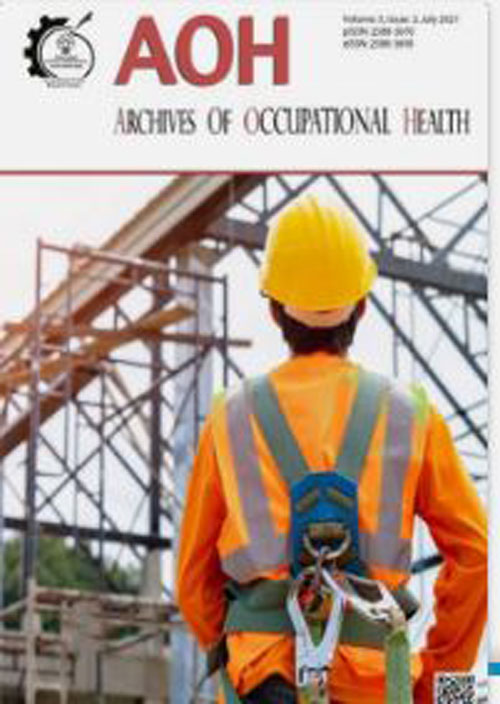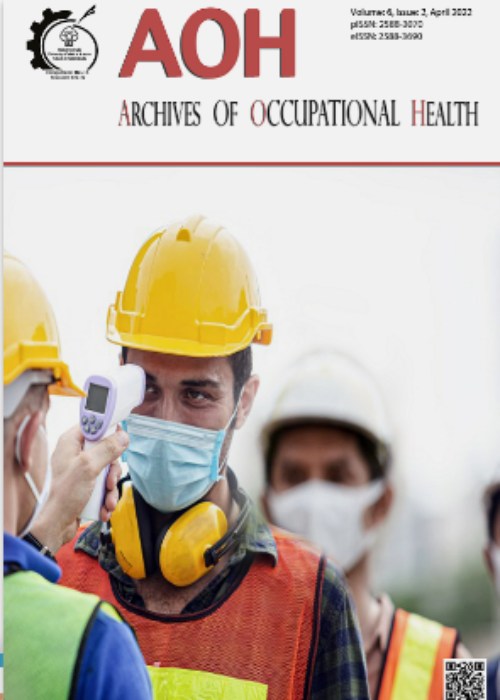فهرست مطالب

Archives Of Occupational Health
Volume:5 Issue: 3, Jul 2021
- تاریخ انتشار: 1400/07/26
- تعداد عناوین: 8
-
Pages 1022-1035Background
This study aimed to determine the incidence of occupational accidents among male workers in an electric power distribution company and to analyze the contributing factors.
MethodsThis prospective cohort study was conducted on 158 male workers from an electricity distribution company in Istanbul (Turkey) between October 2014 and June 2015 in two phases. In the first phase, the data were collected with the face-to-face interviews based on a questionnaire related to the occupational accidents and working conditions in the past year. Then, each worker was followed-up for four months for the occupational accident incidence. The data were analyzed using SPSS software. The degree and magnitude of association between dependent and independent variables were determined by Phi (Φ) and Cramerchr('39')s V coefficient.
ResultsThe incidence rate of self-reported occupational accidents was 47.5% in the past year. The incidence was found to be higher for those aged over 41 (51.7%, p=0.02), work in lighting and overhead line units (71.0% and 47.2%, p=0.04), have occupational disease (66.7%, p=0.01), and have witnessed any occupational accident in the electricity sector (66.1%, p<0.001). The incidence rate was moderately associated with the working unit (Cramer’sV=0.25), witnessing any occupational accident (Φ=0.29), and occupational disease (Φ=0.21). It was higher for those with shift work (52.0%; p=0.29) and with job insecurity (51.8%, p=0.11). The incidence rate of occupational accidents based on four-month follow-up was 0.53 person-year. The most frequent type of accident was explosion (14.3%), and the majority of the accidents resulted in injuries (78.6%).
ConclusionThe incidence of occupational accidents among male workers in the electricity distribution company was higher than the national average. The accidents were significantly related to the working conditions.
Keywords: Occupational Accident, Electricity Worker, Electric Distribution, Electricity Sector, Working Conditions -
Pages 1036-1048Background
Anthropometric studies are essential in furniture design to ensure comfortability and improved productivity of users.
MethodsEquations based on anthropometric principles of Human Factors and Ergonomics were used to assess the match and mismatch between imported plastic and locally made wooden classroom furniture dimensions and student body measurements and their implications on comfortability and musculoskeletal disorders experienced by the students. Additionally, student’s comfortability and musculoskeletal disorders (MSDs) experienced in using the furniture were confirmed with administration of questionnaires.
ResultsMatch between student’s anthropometry and classroom furniture, included only underneath table height for the imported plastic furniture and chair seat height, width and underneath table height for the locally manufactured wooden furniture. Observed mismatches resulted in high incidence of MSDs including upper back (71.40%), lower back (58.30%), neck (51.90%), joint (39.10%), shoulder (32%), knee (25.20%) and wrist (22.60%) pains. The mismatches and prevalence of these MSDs were more in the female than male students. The use of the furniture was discomforting for students with only 6.60% being very comfortable using them.
ConclusionRecommended dimensions for ergonomically-designed furniture has been proposed to reduce MSDs the students suffer, improve student’s health, and promote comfortability to enhance their academic performance
Keywords: Anthropometry, Comfortability, Ergonomics, Furniture, Musculoskeletal disorders -
Pages 1051-1058Introduction
Despite efforts exerted in various areas of the industry to reduce occupational accidents, the frequency of these accidents is reported to be catastrophically high. Therefore, this study was designed and conducted to analyze occupational accidents during a 3-year period.
MethodsThe current study was a retrospective and descriptive-analytical study carried out in four regions of Tehran between 2019-2020. The data collection instrument consisted of 818 reports of the occupational accident recorded in the Department of Labor in Tehran. Feature selection (IBM SPSS Modeler software) and binominal multiple logistic regression analysis (IBM SPSS software) were utilized in this study.
ResultsThe means of age and experience of injured workers were found to be 34.55±11.55 and 14.12±9.87, respectively. The highest rate of occupational accidents belonged to construction workshops (52.4%), production (24.4 %) and other public and social services activities (11.1 %). Data mining and modeling of factors affecting these occupational accidents showed that the consequence of the accidents was affected by seven factors (p<0.05). The results showed that the work experience, type of activity, number of workers, accident time on the day, type of incidence and the causes of the accident remained in the final model and were significant with the consequence of the occupational accidents (p<0.05).
ConclusionThe results indicated that different parameters can affect the occurrence of occupational accidents. Additionally, the consequences of these occupational accidents can be influenced by different parameters and factors.
Keywords: Safety, Occupational accidents, Data mining, Retrospective study -
Pages 1059-1067Background
Different factors affect the success of standard operational procedures (SOPs). This study was conducted to explore the viewpoints of employees of Tehran Oil Refining Company about factors affecting the usability of SOPs.
MethodsThis qualitative study was a conventional content analysis research conducted on the oil refining company employers 2020, using the semi-structured interviews. The data were analyzed by content analysis method using MAXQDA software.
ResultsThe results showed that the employees had a positive perception toward the standard operating procedures and most of them used these procedures to improve work performance and reduce accidents. Also, from the viewpoint of the employees, organizational factors (desirable organizational culture, continuous supervision and evaluation and assurance of accurate implementation of instructions, and continuous personnel training), individual factors (positive perception of the personnel about the organization goals, rules obedience of the personnel, positive experiences of personnel from the implementation of instructions in the past), and environmental factors (environmental dynamics and their related SOP dynamics, desirable but formal relationships of managers and supervisors with personnel as well as optimal and standard work schedule) had a positive effect on the applicability of these procedures.
ConclusionThe findings of this study showed that the employees, consider standard operating procedures of organizational, individual, and environmental factors effective in using standard operating instructions. Therefore, to increase the applicability of these procedures, the employees should consider their opinions.
Keywords: Chemical Industry, Standard Operating Procedures, Qualitative study, Safety -
Pages 1068-1074Background
Construction industry has been ranked among the most dangerous industries worldwide due to the high number of accidents. The safety climate can be considered as a stimulus to reduce unsafe behaviors and thus reduction the accidents. This study was carried out to investigate the relationship between the dimensions of the safety climate and unsafe behavior of the construction workers in Tehran, Iran.
MethodsThe present study is a descriptive cross-sectional research on 90 construction workers. Unsafe behaviors recorded using the American National Standards Institute method and interviews with the workers. The Safety Climate was measured using the UK health care Safety Climate Questionnaire. The descriptive statistics (mean and standard deviation) were used to summarize the findings and the Pearson’s correlation coefficient was used to show the relationship between the variables. The SPSS software was used to analyze the data.
ResultsThe mean and standard deviation of safety climate score and unsafe behavior were (3.98+ 0.27) and (45.93 + 17.3), respectively. There was a significant relationship between unsafe behaviors and staff knowledge (r = -0.31 and P = 0.004). We also found relationship between unsafe behavior and safety climate score (r = -0.21 and P = 0.043).
ConclusionThe employeeschr('39') knowledge was one of the most important components of workplace safety. Also, this component assigned itself the highest score, and increasing the score in this dimension of the safety climate can lead to reduction unsafe behavior. Finally, according to the results, as the safety climate among employees increases, unsafe behaviors will decrease, and productivity would be increase.
Keywords: Unsafe behavior, Safety climate, Construction workers, Workplace safety -
Pages 1075-1083Background
This study aimed to investigate the association between demographic, social, and economic factors of employees and hearing loss.
MethodsIn this cross-sectional study, the required data were extracted from the periodic medical examination of 987 workers in an automotive industry. Kruskal-Wallis and Mann-Whitney tests were used to study the associations. The data were analyzed in the SPSS software.
ResultsIn this study, most of the subjects were in the age group of 30-49 years and also had less than 10 years of working experience. In terms of education level, most of them had a diploma. The relationship between work experience and hearing loss indicated profound hearing loss among a workers with 10 to 20 years of work experience. According to age, the subjects over the age of 55 years had the highest prevalence of hearing loss (p = 0.04).
ConclusionAge and work experience, education, income, and type of job are among the factors that could predict the at risk population for hearing loss.
Keywords: Hearing loss, Socioeconomic status, Automotive industry, Occupational health -
Pages 1084-1091Background
Individuals at shooting ranges are exposed to high amount of lead fumes either indoor or outdoor. The shooters sprayed lead dust into the air upon discharge of the cartridge at arm’s length distance. Most of the previous studies conducted at shooting ranges focused on blood lead levels (BLLs) of exposed people and there are limited studies on the risk associated with the shooting of firearms. This study aimed to review previous studies on the hazards associated with the discharge of firearms, and safety measures at shooting ranges.
MethodsA systematic review was conducted to explore the available evidence. The databases were searched using the keywords “indoor shooting ranges”, “outdoor shooting ranges”, “firearms shooting”, “lead poisoning hazard”, “blood lead biomarkers”, “permissible exposure limit”, and “safety practice on lead”.
ResultsThe designated BLL for case definition in lead poisoning was between 0.1μg/dL - 0.49μg/dL. It was estimated that at Permissible Exposure Limit (PEL). PEL of 0.5μg/m3, 95 percent of range users who are exposed to lead poisoning regularly can have BLL of <5μg/dL during 20 years of working life, while at 2.1μg/m3, 95 percent of the workers can have BLL of<10μg/dL during their working life.
ConclusionTo protect firearm handlers and shooting range workers, policy on preventive measures should be implemented at shooting ranges by policymakers. Compliance with preventive measures is encouraged to avoid the high cost of rehabilitation lead poisoning.
Keywords: Shooting Ranges, Lead Poisoning Hazard, Firearm Handlers, Safety Measures


